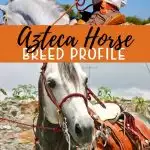The Azteca horse is a symbol of a rich history and cultural pride for the Mexican people. Recognized by the Mexican government as the National Horse of Mexico, Azteca horses are known for their powerful athleticism, excellent agility, and agreeable intelligence. Aztecas are versatile performance horses that are treasured by their owners.
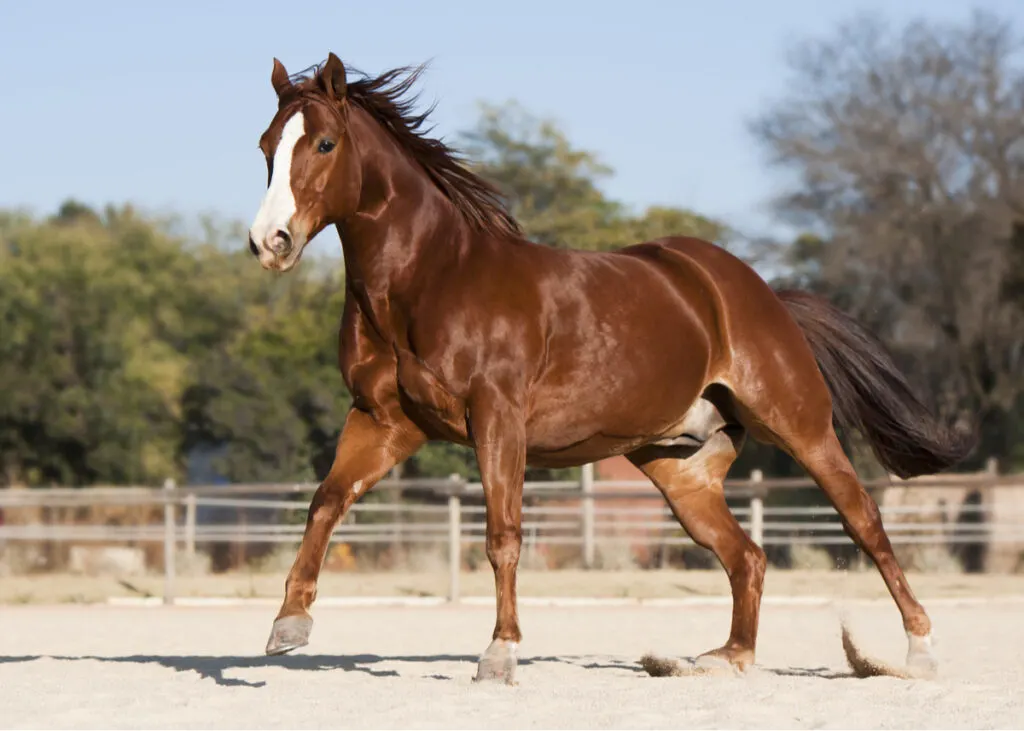
Here are some quick facts about the Azteca horse:
- Origin: Mexico
- Height: 14.3 – 16 hands
- Weight: 1,000 – 2,000 lbs
- Price: $3,000 – $30,000 USD
Table of Contents
History of the Azteca
In the early 1970s, breeders and scientists set out to create a horse breed native to Mexico. All of the horse breeds in Mexico at the time had been developed elsewhere – and Mexico wanted a native breed of their own.
When the Spanish conquistadors brought their Andalusian horses to the Americas in the 1500s, Mexican charros (a “traditional horseman” or “gentleman cowboy”) bred their own versions that were well adapted to the harsh Mexican climate.
The Mexican Criollo was a hardy breed with excellent endurance, and different subtypes of Criollo horses are bred today (mostly in South America). They served well in the Mexican Revolution – but the breed all but disappeared after the war. (source)
To reclaim this lost heritage, a dedicated group of charros sought to create a modern horse that resembled an improved Mexican Criollo. They wanted a horse with the appropriate size, abilities, and temperament for working on the ranch. But, he should also have the elegance and grace of a traditional Spanish horse – with a bold, energetic spirit to match.
In 1972, the charros (a group called Mexicana de Criadores de Caballos de Raza Aztecato) meticulously bred a Spanish stallion named Ocultado to a Quarter Horse mare named Americana. Their foal Casarejo, the first official Azteca horse, was born. (source)
Breed Melting Pot
The Azteca family pedigree is a melting pot of Andalusian, Quarter Horse, and Mexican Criollo blood. A registered Azteca should be a fine example of the best qualities of these breeds.
Some say an Azteca’s front half looks a lot like an Andalusian, and his hind end looks like a Quarter Horse. He may possess no more than 3/4ths or less than 3/8ths of any one foundation breed. (source)
Andalusian/Lusitano
A refined, elegant Spanish horse known for its regal appearance and athleticism. Conquistadors brought their horses to the Americas in the 1500s which changed the landscape forever. Andalusians and Lusitanos excel at dressage and bullfighting, and they make excellent pleasure and performance mounts.
Quarter Horse
These horses are stocky, agile, and exceptionally athletic. They possess great “cow-sense” and are unmatched in speed over short distances. Quarter Horses make excellent ranch horses and are suitable for most other disciplines as well.
This now extinct breed descended from imported Spanish Andalusians. These small, hardy horses were well adapted to the climate of Mexico and served as cavalry mounts during the Mexican Revolution. Variations of the Criollo still exist in South America.
Mexican Criollo
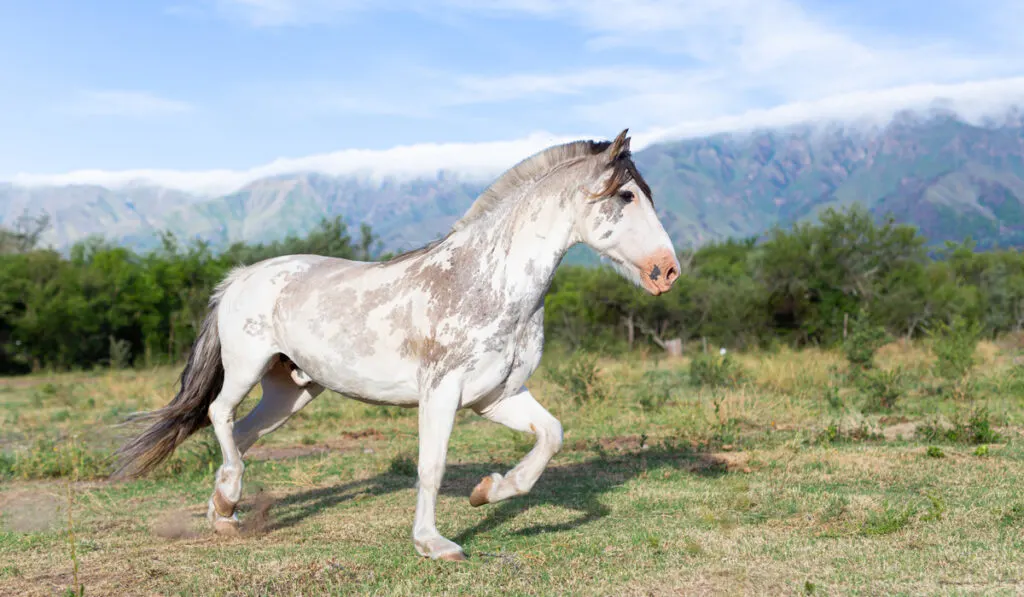
Registry Requirements
The registration requirements for the Azteca are strict. While these horses are crossbreeds, they may not have more than 3/4ths and no less than 3/8ths of their genes coming from one foundation breed alone.
The registry developed a letter system to help identify a horse’s lineage. An “A” level Azteca is a 3rd generation purebred Azteca, with no more than 5/8ths and no less than 3/8ths Andalusian, Lusitano or Quarter Horse.
Not only do Azteca foals have to have proven DNA, but they must also pass rigorous inspections as well. To be eligible for registration, foals must possess the correct phenotype requirements of the Azteca breed (once at 6 months and again at 3 years).
A phenotype is the physical appearance of an animal’s genes. To put it very simply – an Azteca needs to look like an elegant cross between an Andalusian, Quarter horse, and Criollo. Each of these breeds brings a certain phenotype to the gene pool, and a well-bred Azteca must exhibit the best examples of these traits.
Breed Characteristics
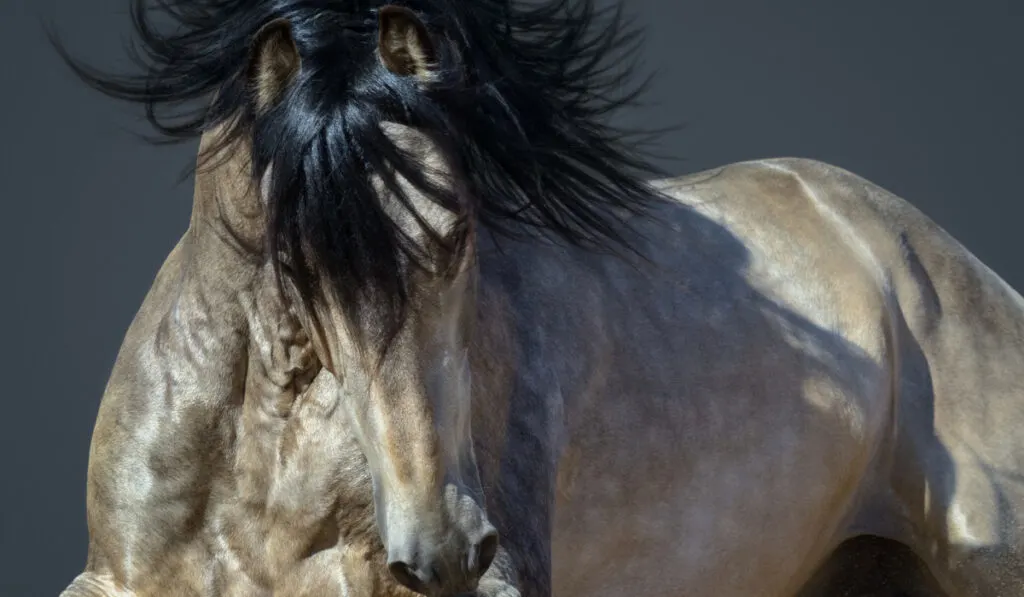
The Azteca combines all of the excellent qualities of the foundation breeds in his pedigree. They are elegant horses with refined conformation thanks to their sophisticated Andalusian ancestors. They are hardy, strong, and their gaits are flowy and elastic.
| Head | Elegant, refined, straight or slightly convex profile, small pricked ears, expressive eyes, may have a long flowing mane. |
| Neck | Well-muscled and slightly arched. |
| Body | Deep broad chests, long sloping shoulder, strong legs, and hooves. |
| Hindquarters | Relatively short back, well-rounded croup, low-set flowing tail |
| Disposition | Spirited but agreeable, bold, intelligent, exhibit a willingness to perform |
Male horses stand between 15 and 16.1 hands and females at 14.3 to 16 hands. A solid warmblood type riding horse, the Azteca usually weighs between 1,000 – 2,000 pounds.
Like their Andalusian predecessors, Azteca horses are elegant movers. They have strong Quarter Horse hindquarters and a large range of motion, which gives them natural collection and suspension. Aztecas have that “floaty trot” which makes them perfect for the dressage and performance rings.
They are also athletic and sensible. Imbued with good “cow-sense” these horses also excel at western stock events, whether competing at the rodeo or working on a cattle ranch.
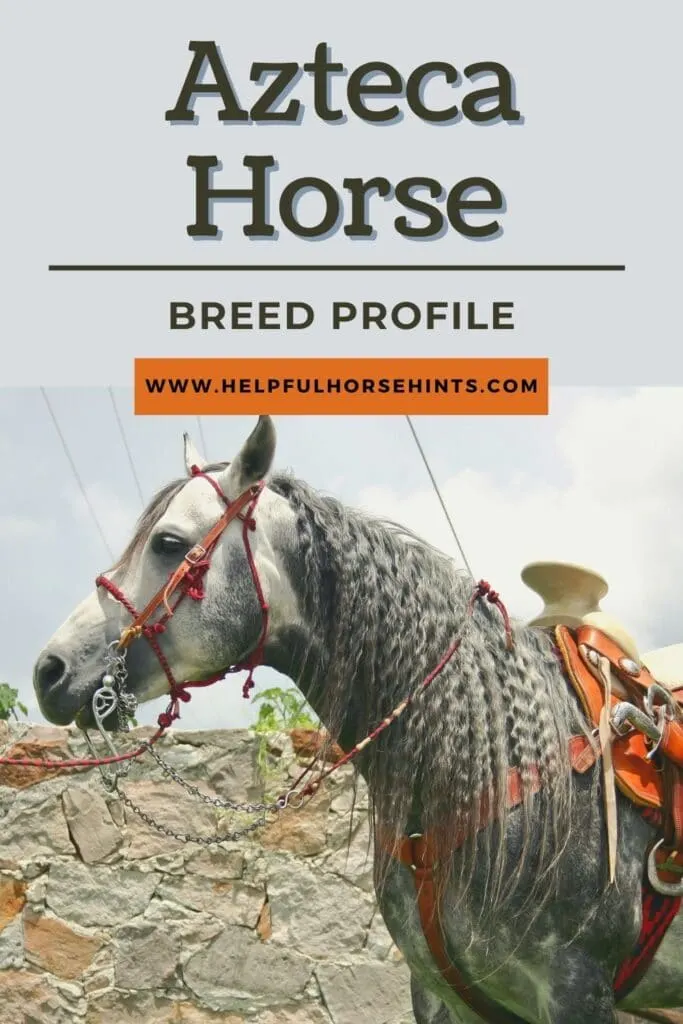
Disciplines
These horses are versatile, athletic, and graceful. They perform well in many different events – from traditional Mexican charreada (rodeo) events such as reining or roping, to classical dressage and bullfighting.
The Azteca is suited for most equestrian disciplines, especially those traditionally suited for Andalusians and Quarter Horses:
- Reining
- Roping
- Tripping
- Bullfighting
- Parades
- Trick riding
- Team roping/tripping
- Classical Spanish riding (alta escuela, haute ecole, high school)
- Doma vaquero or la garrocha
- Dressage
- Parades, rodeo performances
- Trail riding
- Pleasure riding
Colors
The Mexican Azteca horse may come in any solid color (such as bay, brown, gray, chestnut, black, etc), but may not display spotted or patchy coloring. This would indicate a crossbreeding to an Appaloosa or Paint horse somewhere in the pedigree, which is strictly forbidden. Gray is the most common color, and white markings are only allowed on the face and lower legs.
The American Azteca may be any color and may be crossed with registered American Paint Horses.
American Aztecas
In the United States, the Azteca may look slightly different than his Mexican cousin. While these horses are still primarily made up of Andalusian and Quarter horse stock, they may also have Thoroughbred blood as well.
They may also be crossed with paint horses to produce flashy tobiano or overo colored coat patterns. This is strictly prohibited by the Azteca registry in Mexico.
Controversy over “Mexican dancing horses”
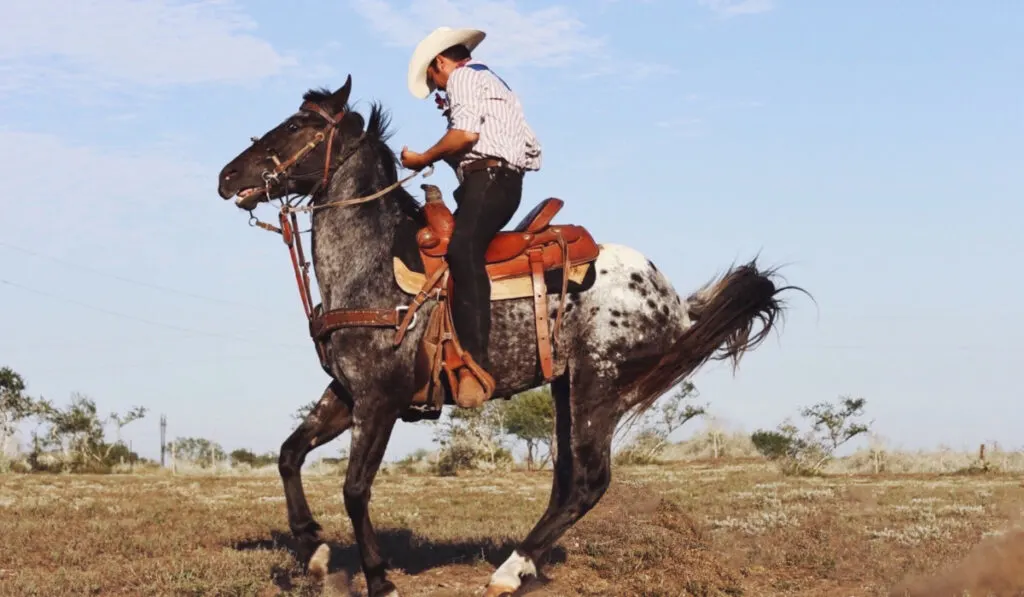
The Mexican charreada is a traditional rodeo competition. Some of the events mirror those found in American rodeos such as reining, roping, and bull or bronc riding. There are also performance events as well. Spectators may catch a glimpse of some famous Mexican “dancing horses.”
These dance movements resemble classical dressage maneuvers such as piaffe and passage (trotting in place). Aztecas are suitably built for “dancing”, but these maneuvers are difficult to properly perform and can take years to master when using proper training techniques.
Unfortunately, many trainers take abusive shortcuts to teach their horses to dance. They tie the horse between two pillars so that he can’t move forward. Then, they hit his legs and feet with whips, so he learns to lift them quickly to alleviate the pain.
Most people won’t be able to tell the difference between a horse that has been treated with respect and trained properly and a horse that has been trained with fear and pain.
Horses communicate with their body language, so here are some things to look out for when you see a “dancing horse” at a rodeo or in a parade.
- Ears. If the horse’s ears are pinned flat against his head, he’s likely uncomfortable or in pain. If his ears are floppy or pricked forward, he is likely more relaxed and willing to perform.
- Tail. When a horse’s tail is actively swishing back and forth, this can indicate annoyance, stress, or pain. If the tail is held low and still, this can indicate that he is relaxed and comfortable.
- Movement. The movements of the dancing horses look like dressage movements, but they’re often jerky and uncoordinated. The horse hasn’t been taught to hold himself properly – he’s just trying to avoid the pain in his feet. Also, a horse that is tossing his head, bucking, randomly jumping, or kicking out with his feet is not relaxed or eager to perform.
It is important to note that not all trainers use abusive tactics to get their horses to perform this way. Many excellent trainers teach their horses with positive reinforcement, repetition, and take excellent care of them.
Note the relaxed tails and soft, quiet demeanor of the Mexican Dancing Horses at this parade. This “trick” is quite suited to horses with higher energy and these horses seem to enjoy performing it.
If the horses look relaxed and happy in the show ring, then the trainers are probably taking care to train their animals properly without abusive shortcuts. If a horse is visibly tense, nervous, or afraid – he may be suffering.
Cost
If you fancy an Azteca for yourself, be prepared to pay for the privilege. In the US, a young American Azteca foal can fetch anywhere from $3,000 – $5,000 depending on their bloodlines.
Pedigreed, well-trained Aztecas rarely come up for sale, and if they do, be prepared to spend $20,000 – $30,000 or more!
However, these horses make excellent companions. If you can get your hands on a good Azteca, you’ll have an excellent equine partner for years to come!

